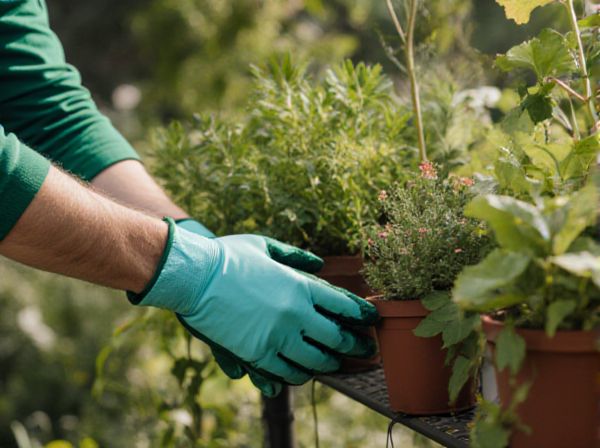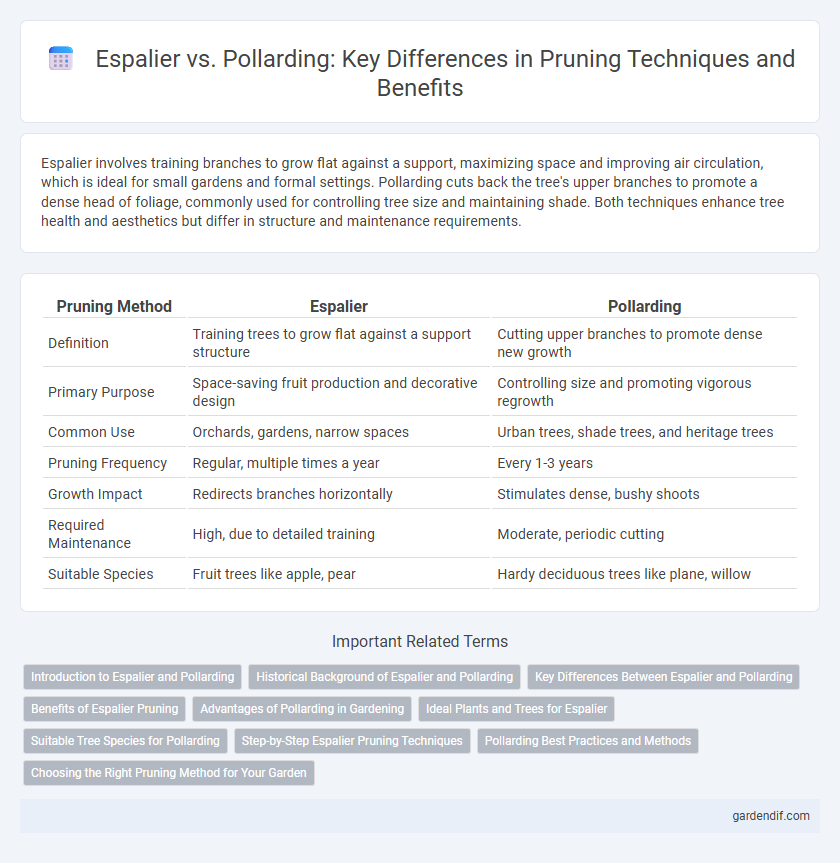
Espalier vs pollarding Illustration
Espalier involves training branches to grow flat against a support, maximizing space and improving air circulation, which is ideal for small gardens and formal settings. Pollarding cuts back the tree's upper branches to promote a dense head of foliage, commonly used for controlling tree size and maintaining shade. Both techniques enhance tree health and aesthetics but differ in structure and maintenance requirements.
Table of Comparison
| Pruning Method | Espalier | Pollarding |
|---|---|---|
| Definition | Training trees to grow flat against a support structure | Cutting upper branches to promote dense new growth |
| Primary Purpose | Space-saving fruit production and decorative design | Controlling size and promoting vigorous regrowth |
| Common Use | Orchards, gardens, narrow spaces | Urban trees, shade trees, and heritage trees |
| Pruning Frequency | Regular, multiple times a year | Every 1-3 years |
| Growth Impact | Redirects branches horizontally | Stimulates dense, bushy shoots |
| Required Maintenance | High, due to detailed training | Moderate, periodic cutting |
| Suitable Species | Fruit trees like apple, pear | Hardy deciduous trees like plane, willow |
Introduction to Espalier and Pollarding
Espalier is a pruning technique that trains trees or shrubs to grow flat against a support, maximizing space efficiency and enhancing fruit production in small gardens. Pollarding involves cutting back the upper branches of a tree to promote a dense head of foliage and maintain size control, commonly used in urban environments. Both methods improve tree management but serve distinct aesthetic and functional purposes.
Historical Background of Espalier and Pollarding
Espalier, originating from ancient Roman and Renaissance European horticulture, was historically used to train trees against flat surfaces for space-saving and decorative purposes. Pollarding dates back to medieval Europe, where it served as a practical method for managing tree growth, ensuring a sustainable supply of wood and fodder without full tree removal. Both techniques reveal centuries-old practices deeply embedded in agricultural and urban forestry traditions.
Key Differences Between Espalier and Pollarding
Espalier involves training trees to grow flat against a structure, optimizing space and sunlight exposure, whereas pollarding is a pruning technique that cuts back the upper branches to promote a dense head of foliage and control tree size. Espalier emphasizes careful, regular pruning for aesthetic and productive purposes, while pollarding focuses on reducing tree height for safety, maintenance, or utility clearance. The main difference lies in espalier shaping the tree's form horizontally and pollarding managing vertical growth.
Benefits of Espalier Pruning
Espalier pruning maximizes space efficiency by training plants to grow flat against a wall or trellis, improving sunlight exposure and air circulation for healthier growth. This method enhances fruit production and eases harvesting by creating accessible, organized branches. Espalier pruning also adds aesthetic appeal to gardens, blending productivity with ornamental design.
Advantages of Pollarding in Gardening
Pollarding offers significant advantages in gardening, such as promoting a controlled, compact tree form that saves space and enhances air circulation, reducing disease risks. This technique encourages vigorous new growth from the upper branches, providing a sustainable source of fresh foliage and wood without damaging the tree's main structure. Unlike espalier, pollarding is less labor-intensive and better suited for managing larger trees in urban gardens or limited spaces.
Ideal Plants and Trees for Espalier
Ideal plants and trees for espalier include fruit-bearing species such as apple, pear, and fig, which respond well to training against flat surfaces. Deciduous trees with flexible branches and strong apical dominance, like cherry and quince, are also suitable for espalier to create structured growth patterns. Evergreens are less common but can be used when precision shaping and decorative patterns are desired in formal garden designs.
Suitable Tree Species for Pollarding
Pollarding is most suitable for species with vigorous regrowth such as London plane (Platanus x acerifolia), linden (Tilia spp.), and hornbeam (Carpinus betulus). These trees tolerate heavy pruning and produce dense crown formations ideal for this technique. Species with flexible branches and high resilience to cutting stresses thrive best under pollarding methods.
Step-by-Step Espalier Pruning Techniques
Espalier pruning involves training trees to grow flat against a support, typically using horizontal branches spaced evenly along a vertical trunk to maximize sunlight exposure and air circulation. Begin by selecting a young, flexible branch and securing it horizontally using ties or wires, then consistently prune upward and downward shoots to maintain the desired shape and remove any inward-growing or crossing branches. Repeat training and pruning cycles annually in late winter or early spring to reinforce structure and encourage fruit production along the trained branches.
Pollarding Best Practices and Methods
Pollarding involves pruning the upper branches of a tree to promote a dense head of foliage and maintain a manageable size, best performed during late winter or early spring to minimize stress and disease risk. Use clean, sharp tools to make cuts just above a bud or branch junction, leaving a short stub to encourage vigorous regrowth while avoiding damage to the trunk. Consistent, cyclical pruning every 1-3 years helps maintain the pollard structure, supports tree health, and prevents overly heavy branches that could break under weight.
Choosing the Right Pruning Method for Your Garden
Espalier pruning shapes trees flat against a structure, maximizing space and sunlight exposure, ideal for small gardens or decorative purposes. Pollarding involves cutting back the tree's upper branches to promote dense growth and maintain a manageable height, suitable for urban areas requiring size control and longevity. Selecting between espalier and pollarding depends on your garden's spatial constraints, aesthetic goals, and the tree species' growth habits.
Espalier vs pollarding Infographic

 gardendif.com
gardendif.com